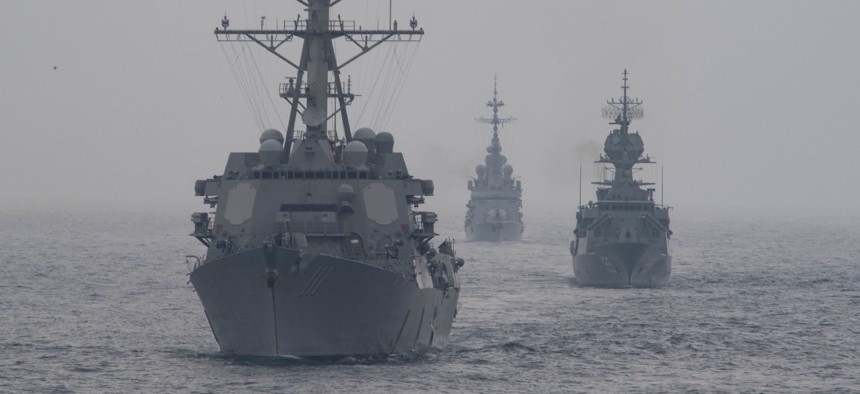
From left, the U.S. Navy destroyer USS Spruance, the Royal Australian Navy frigate HMAS Ballarat , and the French Navy destroyer FS Cassard (D 614) during anti-submarine warfare exercise SHAREM 195 in the Arabian Sea, Dec. 14, 2018. US Navy / Petty Officer 3rd Class Abigayle Lutz
We Don’t Need Airstrikes to Restore Deterrence in the Strait of Hormuz
Recent history shows that a restrained, multilateral military response can help restore stability.
Dr. Christopher Bolan argues convincingly that one reason U.S. deterrence is failing in the Strait of Hormuz is that U.S. policymakers are not clearly communicating their demands. The Army War College professor offers ample evidence of the ambiguity surrounding the Trump administration’s policy priorities, and points out that the United States cannot reasonably expect deterrence to succeed if it doesn’t clearly communicate what behaviors will result in punishment. However, Dr. Bolan and others have argued that the administration should punish Iran’s provocations with kinetic action against the Iranian Revolutionary Guard Corps while signaling the precise cause of the action and the price for continued escalation. This would be a dramatic escalation and serious policy misstep.
Instead of deterring Iran, such action would almost certainly draw a matching escalation, whether in the Strait of Hormuz or elsewhere in the region, pulling the two nations yet closer to outright hostilities. U.S. policymakers should look to recent history to better understand Iran’s tactics as well as craft intermediate policy solutions that avoid war.
Over the past decade, Iran has threatened several times to disrupt traffic through the Strait of Hormuz. After one such threat in 2012, the U.S., Britain, and France sent a joint naval force through the strait while key policymakers conveyed the consequences of further instigation. The U.S. also sent additional fighter jets and naval assets to the region, including mine-clearing vessels and an extra carrier group. Three years later, after Iranian vessels harassed and detained commercial vessels in the Strait, U.S. patrol boats began escorting ships through the passage. And after Iran briefly detained a U.S. naval vessel in the Persian Gulf in 2016, quick, high-level diplomacy avoided armed confrontation. In each of these cases, the United States restored stability to the strait without recourse to violence.
Related: Deterrence Is Failing — Partly Because Iran Has No Idea What the US Really Wants
Related: The Many Ways Iran Could Target the United States
Related: US Arms Sales to the Gulf Have Failed
These examples provide practical policy alternatives to the direct application of force. Perhaps the 2015 case offers a model for the most prudent course: placing U.S. military assets close enough to observe and counteract harassment or sabotage. Further, U.S. officials should attempt to organize a robust multinational mine-clearing operation in the strait – effectively operationalizing the annual International Maritime Exercise or the quarterly Mine Countermeasures Exercise (MCMEX) alongside a sustained escort mission. The U.S. would be well advised to coordinate its forces with other states that have an interest in maintaining regional commerce. Given the economic importance of the strait, there is no shortage of potential coalition members. Strong candidates include India, Japan, or South Korea, which have close ties to the United States, vested interests in stability, and which collectively consume about 30-40 percent of the oil that flows through the strait. India has already dispatched warships to the region to help ensure the safety of their vessels. Other candidates include major exporters of oil who use the strait: Saudi Arabia, Kuwait, and the UAE. And France and the UK are already participants in exercises supporting freedom of navigation in the strait.
An international force organized to ensure safe passage for commercial vessels would also create a more capable military tripwire, which would in turn better deter any further sabotage. Additional mining would have to be done in close proximity to a robust military force. Confrontations or miscalculations could easily result in injury or death to coalition members, raising the stakes for Iran. The additional forces in the region would also allow for more effective detection and monitoring of any bad behavior, thus reducing the ambiguity of further attacks and setting a clearer red line. Together these factors would force Iran to anticipate a kinetic response by the United States, backed by an international coalition, raising the cost of provocation. Given Iran’s hesitance to risk direct armed confrontation with U.S. forces in the strait, informed by their past experience with the U.S. Navy, such a display of force and international unity would likely be enough to reestablish deterrence. This policy option can place the onus for escalation squarely on Iran, depriving them of their ability to harass shipping, deterring them from militarily retaliation against sanctions enforcement, and reassuring allies and global markets of the stability of the strait.
Despite Iranian leaders’ wariness of direct confrontations with the U.S. military, recent events demonstrate their willingness to use coercion to press for sanctions relief and to take direct military action when they feel their territory is threatened. Given the Strait of Hormuz’s critical role in the global economy, U.S. policymakers would be wise to exercise restraint and maximize the chances of de-escalation and stability, rather than war.



